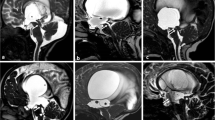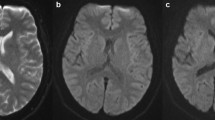Abstract
Purpose
To evaluate efficacy of three-dimensional (3D) heavily T2-weighted (W) MRI sequences in assessment of cerebrospinal fluid (CSF) pathways and to compare two different types of 3D heavily T2W MRI sequences (CISS and SPACE) with two-dimensional (2D) T2W turbo spin echo (TSE) sequences for hydrocephalus with intraventricular obstruction.
Materials and methods
Sixty-two patients who were diagnosed with intraventricular obstructive hydrocephalus, according to clinical and radiological findings, were included in this retrospective study. 2D-TSE-T2, 3D-CISS, and 3D-SPACE, which are part of the protocol, were analyzed quantitatively by measuring ventricle-to-parenchyma contrast-to-noise ratio (CNR), and qualitatively by evaluating the capabilities of visualization of the obstructive pathology, overall image quality, severity of artifacts, and delineation of the CSF pathways. One-way ANOVA and Friedman’s test were used for statistical analysis.
Results
CNR between CSF and brain parenchyma was significantly higher using 3D-SPACE sequences compared with 3D-CISS and 2D-TSE-T2 sequences. The qualitative findings showed that 3D heavily T2W sequences were superior to 2D-TSE-T2 sequences. 3D-SPACE sequences showed fewer artifacts than 3D-CISS or 2D-TSE-T2 sequences.
Conclusion
3D heavily T2W sequences are necessary tools for assessment of CSF pathways in patients with intraventricular obstructive hydrocephalus. 3D-SPACE sequences allowed heavy T2W, which is necessary for CSF flow imaging and provided significantly fewer image artifacts and improved CNR in comparison with 3D-CISS sequences.



Similar content being viewed by others
References
Rekate HL. A consensus on the classification of hydrocephalus: its utility in the assessment of abnormalities of cerebrospinal fluid dynamics. Childs Nerv Syst. 2011;27:1535–41.
Kartal MG, Algin O. Evaluation of hydrocephalus and other cerebrospinal fluid disorders with MRI: an update. Insights Imaging. 2014;6:531–41.
Hodel J, Rahmouni A, Zins M, Vignaud A, Decq P. Magnetic resonance imaging of noncommunicating hydrocephalus. World Neurosurg. 2013;79(S21):e9–12.
Dinçer A, Özek MM. Radiologic evaluation of pediatric hydrocephalus. Childs Nerv Syst. 2011;27:1543–62.
Awaji M, Okamoto K, Nishiyama K. Magnetic resonance cisternography for preoperative evaluation of arachnoid cysts. Neuroradiology. 2007;49:721–6.
Kojima S, Suzuki K, Hirata M, Shinohara H, Ueno E. Depicting the semicircular canals with inner-ear MRI: a comparison of the SPACE and TrueFISP sequences. J Magn Reson Imaging. 2013;37:652–9.
Mugler JP, Bao S, Mulkern RV, Guttmann CRG, Robertson RL, Jolesz FA, et al. Optimized single-slab three-dimensional spin-echo MR imaging of the brain. Radiology. 2000;216:891–9.
Watanabe Y, Makidono A, Nakamura M, Saida Y. 3D MR cisternography to identify distal dural rings: comparison of 3D-CISS and 3D-SPACE sequences. Magn Reson Med Sci. 2011;10:29–32.
Fushimi Y, Miki Y, Ueba T, Kanagaki M, Takahashi T, Yamamoto A, et al. Liliequist membrane: three-dimensional constructive interference in steady state MR imaging. Radiology. 2003;229:360–5.
Aleman J, Jokura H, Higano S, Akabane A, Shirane R, Yoshimoto T. Value of constructive interference in steady-state three-dimensional, Fourier transformation magnetic resonance imaging for the neuroendoscopic treatment of hydrocephalus and intracranial cysts. Neurosurgery. 2001;48:1291–5 discussion 1295–6.
Dinçer a, Kohan S, Ozek MM. Is all “communicating” hydrocephalus really communicating? Prospective study on the value of 3D-constructive interference in steady state sequence at 3T. AJNR Am J Neuroradiol. 2009;30:1898–906.
Held P, Fellner C, Fellner F, Seitz J, Strutz J. MRI of inner ear anatomy using 3D MP-RAGE and 3D CISS sequences. Br J Radiol. 1997;70:465–72.
Algin O, Hakyemez B, Parlak M. Phase-contrast MRI and 3D-CISS versus contrast-enhanced MR cisternography on the evaluation of the aqueductal stenosis. Neuroradiology. 2010;52:99–108.
Algin O, Turkbey B. Evaluation of aqueductal stenosis by 3D sampling perfection with application-optimized contrasts using different flip angle evolutions sequence: preliminary results with 3T MR imaging. AJNR Am J Neuroradiol. 2012;33:740–6.
Algin O, Turkbey B, Ozmen E, Ocakoglu G, Karaoglanoglu M, Arslan H. Evaluation of spontaneous third ventriculostomy by three-dimensional sampling perfection with application-optimized contrasts using different flip-angle evolutions (3D-SPACE) sequence by 3T MR imaging: preliminary results with variant flip-angle mode. J Neuroradiol. 2013;40:11–8.
Naganawa S, Koshikawa T, Fukatsu H, Ishigaki T, Fukuta T. MR cisternography of the cerebellopontine angle: comparison of three-dimensional fast asymmetrical spin-echo and three-dimensional constructive interference in the steady-state sequences. AJNR Am J Neuroradiol. 2001;22:1179–85.
Haystead CM, Dale BM, Merkle EM. N/2 ghosting artifacts: elimination at 3.0-T MR cholangiography with SPACE pulse sequence. Radiology. 2008;246:589–95.
Conflict of interest
The authors declare that they have no conflict of interest.
Author information
Authors and Affiliations
Corresponding author
About this article
Cite this article
Ucar, M., Tokgoz, N., Damar, C. et al. Diagnostic performance of heavily T2-weighted techniques in obstructive hydrocephalus: comparison study of two different 3D heavily T2-weighted and conventional T2-weighted sequences. Jpn J Radiol 33, 94–101 (2015). https://doi.org/10.1007/s11604-014-0385-y
Received:
Accepted:
Published:
Issue Date:
DOI: https://doi.org/10.1007/s11604-014-0385-y




